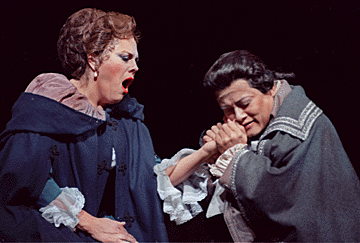


HOT hosts grand
‘Masked Ball’Un Ballo in Maschera: A Masked Ball: Presented by Hawaii Opera Theatre at the Neal Blaisdell Concert Hall. Repeats 7:30 p.m. tomorrow. Tickets are $23 to $77. Call 596-7372 or 1-(800)-836-7372.
By Ruth O. Bingham
Special to the Star-BulletinHAWAII Opera Theatre opened its opera season with a charming production of Verdi's "Un Ballo in Maschera (A Masked Ball)," set in the original 17th century Sweden. The production, conventional in approach, provides no shocks (other than the startling gunshot that launched half the audience out of their seats), just pleasant surprises.
The cast, as a whole fine if also unremarkable, delivered several wonderful individual moments, Friday night. Soprano Pamela South (Amelia) had the strongest voice, a voice that continued to improve throughout the evening, eventually revealing clear upper notes, a wide range and good dynamic control. Of special note was her pleading to see her son one last time in Act II.
Tenor Warren Mok (King Gustavus), brought in to replace Keith Ikaika-Purdy, suited his role well with his noble bearing and refined movements. His voice, although not as large as South's, was of fine quality and he shone in several ensembles and solos.
South and Mok, both individually strong singers, lacked sufficient passion as a couple to overcome inequities between their voices. That notwithstanding, they acted well together.
"A Masked Ball" is an opera of dark voices coming together for even darker plans. Of the several baritones and bass-baritones, Louis Otey (the king's advisor Anckarstrom) possessed the strongest voice. Well cast with his dark, full voice and tall stature, he made a believable loyal advisor/friend and disillusioned idealist.
Baritone Leslie Tennent (Count Horn) and bass-baritone John Mount (Count Ribbing) made their marks in one of Verdi's famous scenes, the mocking of Anckarstrom and laughing ensemble. The opera reached an unusual vocal climax in Act II, when three dark-voiced baritones gathered to plot assassination.
The fourth dark-voiced baritone, bass-baritone Quinn Kelsey (Christian, the sailor), may be young, but he has a rich, velvety, dynamite voice. He will be one to watch.
Even mezzo-soprano Marion Pratnicki (Madame Arvidson) had a dark voice, though not as dark as some mezzos. Hazy in her upper ranges, Pratnicki possesses a good character voice, with a wide variety of timbres.
The only light note in the cast was offered by coloratura soprano Leda Asher Yager (Oscar, the page). Revealing a clear, light, lovely voice with admirable coloratura technique, Asher Yager's voice suited well the role of a young boy, but her singing tended to be overpowered in ensembles and was often difficult to hear in mid- to low-ranges.
Staging revealed some fine work by director Matthew Lata. In an opening pantomime, for example, Lata used a scrim to portray King Gustavus' thoughts of forbidden love and to foreshadow the opening of Act III, neatly linking beginning to end. Contrary to traditional staging, Lata intermingled conspirators and loyal subjects, clearly delineating the rift only when the king died. Although it robbed Counts Horn and Ribbing of early distinction, the staging worked theatrically and underscored that the country was held together by the king.
The Rainbow Jugglers added much life to the masked ball and provided the perfect touch of concentrated levity. All the activity going on behind the ornate arches walked a narrow line of interest between boring and distracting without ever stepping too far to either side.
There were, of course, minor mishaps throughout: wigs not adhering, boxes sticking shut, missed notes, and so on, but those are inevitable in live performance and none interfered with the overall high quality. Protracted scene changes probably unavoidable in this hall required more patience than modern audiences are accustomed to, but rented sets by Jay Depenbrock made the waiting worthwhile.
Depenbrock's subtly innovative sets were effective. Combined with Peter Dean Beck's lighting and Lata's staging, the sets ingeniously suggested walls that shifted to suit the action. Seemingly solid walls that separated people one moment became open corridors or interior pillars the next. Lounging beside a draped fishing net, King Gustavus was both in and outside Madame Arvidson's den, which is itself neither clearly inside nor out.
Mist rising through the gallows field at midnight elicited well-deserved applause: the set is striking. And a "face" on the gallows wall, intentional or not, is wonderfully suggestive and frightening.
Singing in opera may be hard, but dying in opera is a lot harder. It requires more "suspension of disbelief" than probably any other moment. Face it: there is no good position for singing and dying at the same time, so Mok's awkward drooping on a bench before a remarkably well-disciplined crowd, while entirely unbelievable, was nonetheless a goods olution. Fine costumes notwithstanding, a less tidy blood stain might have been nice. In the end, Mok chose more realistic dying over his final high note, a sacrifice above and beyond any tenor's call of duty and further proof of his noble character.
If the on-stage crowd reacted to the gunshot rather calmly, the auditorium crowd supplied everything missing, startling and yelping, rustling and chattering so as to drown out the following measures. An (intended?) audience participation moment.
Conductor Mark Flint, with his birdlike left hand fluttering in the lights, held it all together admirably, even through some difficult entrances and rough ensembles. He carefully balanced voices and instruments, making the evening a delightful success.
Click for online
calendars and events.